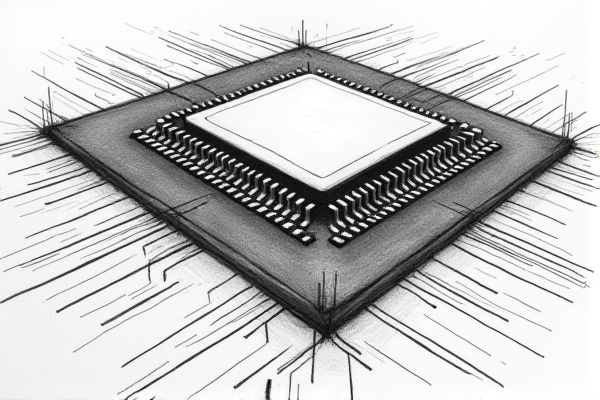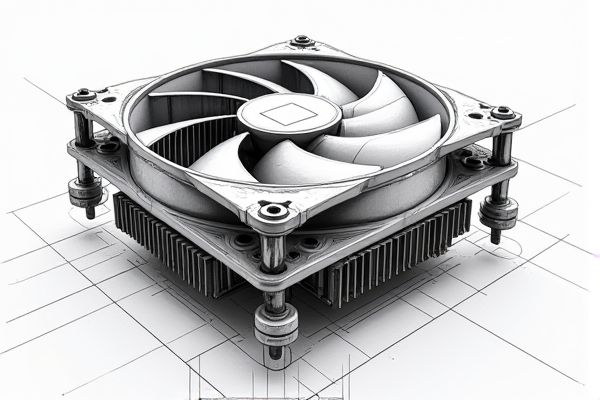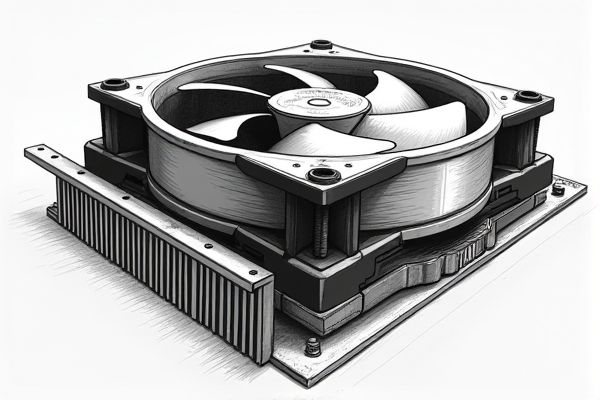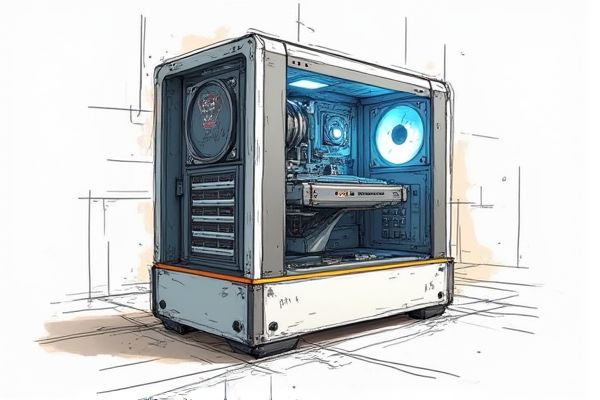In today's rapidly evolving tech landscape, choosing the right CPU for your computing needs can be daunting, given the plethora of options available. Whether you're building a gaming rig, assembling a powerful workstation, or seeking a reliable processor for everyday tasks, selecting a brand that balances performance, value, and innovation is crucial. Various brands have carved out reputations for excellence in different categories, providing CPUs that excel in power efficiency, overclocking capabilities, and integrated technologies. Below, we explore some of the top brands renowned for their exceptional CPU offerings.

Illustration of cpus
Best brands of cpus in 2025
Intel
Intel remains a dominant force in the CPU market, securing a 78.9% market share in the client PC segment in Q2 2024, despite AMD's gains. In the server market, Intel still controls 75.9% of datacenter CPU shipments, although AMD has made significant strides, particularly in high-end server CPUs. Intel's strong product lineup and vast production capacity continue to support its market leadership. However, AMD has been closing the gap, especially in desktops, where AMD's market share rose to 28.7% in Q3 2024. Intel's market share in desktops has declined to 71.3%, partly due to inventory adjustments. For more technical insights, you can view their Intel Core Ultra Processor Datasheet.
AMD
AMD has solidified its position as a leading CPU producer, capturing 28.7% of the desktop market share in Q3 2024, a significant 9.6% annual gain and the highest share since late 2016. The company also achieved a 22.3% market share in laptops and 24.2% in servers, with a record 33.9% revenue share in server-related chips. AMD's success is driven by robust sales of its Ryzen 9000 series and EPYC processors, contributing to a $3.549 billion quarterly revenue in the data center segment. This growth underscores AMD's strong performance trajectory, especially in the high-end CPU market where it has outperformed Intel in revenue share. AMD's innovative Zen 5 processors and 3D V-Cache technology have been key factors in its market gains.
Apple
Apple dominates the ARM-based CPU market, holding a staggering 90% of the market share for ARM computers, primarily due to its innovative M-series chips. These chips, based on ARM architecture but heavily customized by Apple, have driven significant growth, with ARM-based PCs expected to double their market share from 14% to 25% by 2027. Apple's M-series chips are highly customizable, integrating advanced features like the Neural Engine for AI and machine learning tasks, and are known for their efficiency and performance. In Q3 2023, Arm system-on-chips commanded 10.6% of the PC market share, with Apple's Mac shipments being a major contributor. Apple's commitment to security and performance has made its silicon a benchmark in the industry.
Qualcomm
Qualcomm is a leading producer of CPUs, particularly in the smartphone and semiconductor industries, with a significant market presence. As of 2023, Qualcomm held a 23% market share in smartphone application processors, though MediaTek has recently overtaken them in the 5G smartphone chip market with a 29.2% share in Q1 2024, compared to Qualcomm's 26.5%. Qualcomm's revenue peaked at $44.2 billion in 2022 and was $35.82 billion by the end of 2023, with China being its highest-grossing region, generating $22.382 billion in revenue. The company also has a strong position in the semiconductor market, with a 5.4% market share as of 2023, and it is anticipated to generate around $48 billion in sales in 2024. Qualcomm's investment in research and development, such as the $7.5 billion spent in 2023, helps maintain its leadership. For more detailed insights into Qualcomm's market position and statistics, visit their statistics page.
ARM
ARM is a leading producer of CPUs, particularly notable for its system-on-chips (SoCs) that commanded a 10.6% market share in the PC sector in Q3 2023, a significant increase from the 2-3% share in 2020. The ARM architecture offers advantages such as improved power efficiency, lower heat generation, and greater design flexibility. Despite a recent dip, ARM's market share has been steadily growing, with a predicted market value of USD 52.65 billion by 2030, driven by a CAGR of 28.30% from 2024 to 2030. Major players like Apple, Qualcomm, and NVIDIA are adopting ARM-based processors for their high-performance and energy-efficient capabilities. The growth is further fueled by the increasing demand for cloud services and the robust adoption of digital transformation in regions like Asia Pacific. For a comprehensive analysis, refer to the ARM-based PC processors market report.
IBM
IBM is a significant player in the CPU market, though it does not dominate the x86 CPU segment, which is largely controlled by Intel and AMD. As of Q3 2024, IBM holds a 9.58% market share in the computer hardware industry, and 4.13% in the broader technology sector. IBM's POWER8 processors are notable for their use in high-performance computing, particularly in servers and specialized systems. While IBM's market share is substantial, it is dwarfed by companies like Apple and Dell in the hardware sector. IBM's focus on high-performance and specialized CPUs sets it apart in the market.
NVIDIA
NVIDIA has solidified its position as a dominant force in the GPU market, holding an impressive 88% market share as of Q1 2024, a significant increase from the 80% in the previous quarter. This growth has been largely at the expense of AMD, whose share dropped to 12%, and Intel, which lost its entire 1% market share. NVIDIA's dominance is fueled by its innovative hardware and software advancements, particularly in the AI and datacenter segments, where it generates substantial revenues. In fiscal 2024, NVIDIA's revenue from its Compute & Networking segment reached nearly $47.4 billion, highlighting its strong presence in AI and high-performance computing. The company's rapid innovation cycle, including annual releases of new flagship architectures, further cements its leadership in the industry. For more insights on NVIDIA's market dynamics, visit this TechRadar article.
MediaTek
MediaTek has emerged as a leading producer of CPUs, particularly in the 5G smartphone market, with its market share rising to 29.2% in Q1 2024 from 22.8% in Q1 2023, as reported by Omdia's Smartphone Model Market Tracker. This growth is driven by a remarkable 53% increase in shipments of 5G smartphones powered by MediaTek, reaching 53 million units in Q1 2024. MediaTek's strategic focus on mid-to-low-end price tiers, particularly phones priced under $250, has been a significant contributor to its success. Furthermore, the company's strong partnerships with Chinese smartphone OEMs such as Transsion and Xiaomi have played a crucial role in its market expansion. While MediaTek's latest 9000 series of chips aims to capture a share of the premium segment, Qualcomm's Snapdragon continues to hold dominance in this area. For further insights, you can read more about how MediaTek overtakes Qualcomm in the 5G smartphone chip market.
HiSilicon
HiSilicon, the semiconductor division of Huawei, has shown significant growth in the global smartphone chip market, shipping 8 million Kirin units in Q1 2024 and capturing a 2.7% market share. This marks a notable resurgence for the company, especially after a period of zero shipments in the previous year. Despite being sixth in the global rankings, HiSilicon's progress is promising, with the company surpassing Google in both chipset shipments and revenue during Q1 2024. Huawei's Kirin chips, particularly those in the Mate and Nova series, have drawn considerable attention, contributing to the company's gradual comeback in the chipset market. With upcoming launches like the Mate 70 series and HarmonyOS Next, HiSilicon is poised for further growth.
Samsung
Samsung is a leading producer of semiconductors, having surpassed Intel as the world's biggest chipmaker by revenue in 2017 and maintaining this position for two years. As of 2023, Samsung's global market share in the semiconductor industry was 7.5%, although this represents a decline from 12.3% in 2021. Despite this, Samsung remains a significant player, manufacturing a wide range of components including memory chips, system LSI, and foundry services. In the first quarter of 2024, Samsung captured an 11% market share in the global semiconductor market, excluding foundry services. The company's semiconductor revenue in 2023 was approximately $39.9 billion, down from $63.8 billion in 2022. For more detailed insights into their market performance, read the full report on Samsung's semiconductor market share.
















Leave a Reply
Your email address will not be published.